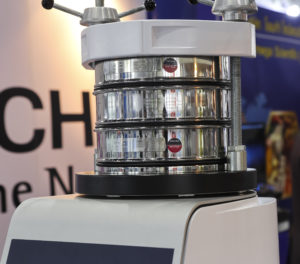Why is there a growing preoccupation with particle size?
It’s because particle size can alter the efficacy (e.g., bioavailability) and safety profile (e.g., toxicity) of a compound.
 Complex particle sizing is a growing trend, and expertise in particle reduction techniques for intermediates is evolving into a niche capability in its own right. It has taken on even more importance in recent years as the number of insoluble compounds with low bioavailability grows. And with dosages becoming smaller, tight control over particle size is even more critical.
Complex particle sizing is a growing trend, and expertise in particle reduction techniques for intermediates is evolving into a niche capability in its own right. It has taken on even more importance in recent years as the number of insoluble compounds with low bioavailability grows. And with dosages becoming smaller, tight control over particle size is even more critical.
According to PharmTech (Particle Size Reduction for Investigational New Drugs):
“More than 90% of small-molecule NCEs designed to be taken orally display solubility issues. Poor solubility makes absorption of the drug from the gastrointestinal tract into the bloodstream a challenge, and the resulting low bioavailability may require enabling technologies to achieve a therapeutic effect.
Most APIs in current development fall into DCS quadrant II (see chart, left), in that they have poor solubility but adequate permeability.”
Particle Size Distribution, or PSD, requirements are critical, since the smaller the particle size, the greater the efficacy (as there is a larger surface area – which translates to higher bioavailability). But if the particle size is too small, it could lead to toxicity. So the right balance has to be found.
The distribution of the particle sizes in a sample is a physical parameter, and is typically achieved using techniques such as controlled crystallization, post-drying micronization (e.g. jet milling) and wet milling.
How Many Requirement Tiers Are There?
Many projects involve products with a single tier of PSD requirements, for example, d90 < 10 microns (90% of the particles are 10 microns or less). As with any pharma project, challenges can arise even during single tier requirement products.
Projects become more challenging with two-tier requirements, in which materials are required to meet two distinct specifications. As the specifications move to three tiers, the difficulties become even more magnified. Controlling the particle sizes – for example, matching between the various tiers of d50/d90 – can require a combination of different particle reduction and particle sizing techniques.
Complex Particle Size Distribution Projects
In response to the growing need for tight control over particle size, Neuland launched a dedicated particle size engineering lab containing facilities for both dry and wet milling, and micronization. Some projects requiring a specific particle size and distribution have been completed which necessitated the use of all three size reduction methods. We’ve also adopted the latest particle size engineering technologies, including implementing inline and online particle size meters as well as the latest crystallization techniques.
We’ve conducted particle size engineering studies using micronization for products such as Indacaterol maleate (less than 5 microns) and Ticagrelor (less than 10 microns). In another project, data generated on experiments with the compound Levetiracetam were used to optimize process conditions to meet the PSD requirement prior to kg scale production.
The Four-Tier Specification – QbD & Labwork
Neuland recently worked on a project where the Particle Size Distributions (PSD) requirements were quite unique.
The product consisted of a 4-tier PSD specification. The API required a specific percentage mix of particle sizes to meet the customer’s formulation needs. The project also called for careful attention to the physical powder properties, to avoid negatively impacting processing & bulk powder handling.
When scaling a project from the bench to commercial bulk API quantities, knowledge of size reduction techniques and their impact on characteristics (e.g., flowability & hardness) is vital to successful process development.
This 4-tier project required a great deal of lab work. Using a QbD (Quality by Design) approach to process development, the team in Neuland’s Process Engineering (PE) Lab developed an efficient, effective and safe process to achieve the necessary complex specs.
QbD provides an effective framework under which processes can be modified to account for variations in the properties of the API. The project leveraged a number of QbD elements – process control, continuous improvement, Design of Experiments (DoE) and Design Space – to ensure a viable & scalable process emerged.
Neuland made key decisions during the process development project to achieve the customer’s unique specifications.
Instead of using a multi-milling technology, we chose a jet-stream milling technique. Jet mills grind materials using a jet of air or gas to impact particles into each other. Multimills operate differently, relying on beaters with different rotating edges to granulate and screen particles.
Neuland designed and created a special sieve to meet all four of the size specifications. (The actual process by which we arrived at the right sieve is confidential, but it was a critical aspect in driving development and commercialization forward.)
Particles in All Shapes & Sizes
From novel drug delivery techniques (e.g., inhalables) to the efficacy and safety of intermediates, particle size now plays a prominent role in pharma drug development & scale-up. The data generated by particle size distribution studies and experiments has expanded upstream – away from typical dosage form considerations – and is now used by the pharma industry earlier in the drug design process.
Are you ready to talk about your molecules? Contact us today.










